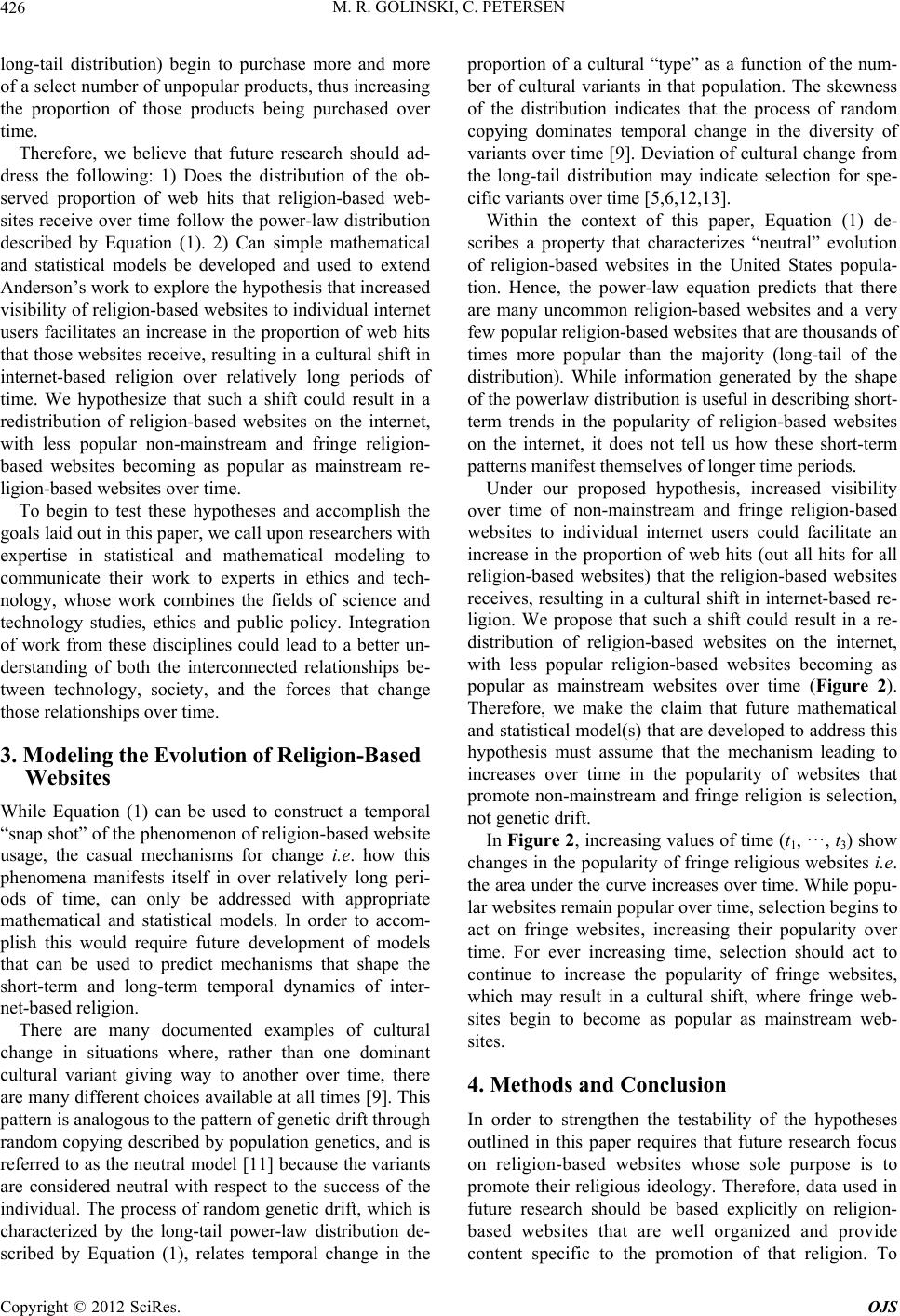
M. R. GOLINSKI, C. PETERSEN
426
long-tail distribution) begin to purchase more and more
of a select number of unpopular produ cts, thus increasing
the proportion of those products being purchased over
time.
Therefore, we believe that future research should ad-
dress the following: 1) Does the distribution of the ob-
served proportion of web hits that religion-based web-
sites receive over time follow the power-law distribution
described by Equation (1). 2) Can simple mathematical
and statistical models be developed and used to extend
Anderson’s work to explore the hypothesis that increased
visibility of religion-based websites to individual in ternet
users facilitates an increase in the proportion of web hits
that those websites receive, resulting in a cultural shift in
internet-based religion over relatively long periods of
time. We hypothesize that such a shift could result in a
redistribution of religion-based websites on the internet,
with less popular non-mainstream and fringe religion-
based websites becoming as popular as mainstream re-
ligion-based websites over time.
To begin to test these hypotheses and accomplish the
goals laid out in this paper, we call upon researchers with
expertise in statistical and mathematical modeling to
communicate their work to experts in ethics and tech-
nology, whose work combines the fields of science and
technology studies, ethics and public policy. Integration
of work from these disciplines could lead to a better un-
derstanding of both the interconnected relationships be-
tween technology, society, and the forces that change
those relationships over time.
3. Modeling the Evolution of Religion-Based
Websites
While Equation (1) can be used to construct a temporal
“snap shot” of the phenomenon of religion-based website
usage, the casual mechanisms for change i.e. how this
phenomena manifests itself in over relatively long peri-
ods of time, can only be addressed with appropriate
mathematical and statistical models. In order to accom-
plish this would require future development of models
that can be used to predict mechanisms that shape the
short-term and long-term temporal dynamics of inter-
net-based religion.
There are many documented examples of cultural
change in situations where, rather than one dominant
cultural variant giving way to another over time, there
are many different choices available at all times [9]. This
pattern is analog ous to the pattern of gene tic drift through
random copying described by population genetics, and is
referred to as the neutral model [11] because the variants
are considered neutral with respect to the success of the
individual. The process of random genetic drift, which is
characterized by the long-tail power-law distribution de-
proportion of a cultural “type” as a function of the num-
ber of cultural variants in that population. The skewness
of the distribution indicates that the process of random
copying dominates temporal change in the diversity of
variants over time [9]. Deviation of cultural change from
the long-tail distribution may indicate selection for spe-
cific variants over time [5,6,12,13].
Within the context of this paper,
scribed by Equation (1), relates temporal change in the
Equation (1) de-
sc
ility
ov
creasing values of time (t1, ···, t3) show
ch
4. Methods and Conclusion
ty of the hypotheses
content specific to the promotion of that religion. To
ribes a property that characterizes “neutral” evolution
of religion-based websites in the United States popula-
tion. Hence, the power-law equation predicts that there
are many uncommon religion-based websites and a very
few popular religion-based websites th at are thousands of
times more popular than the majority (long-tail of the
distribution). While information generated by the shape
of the powerlaw distribution is useful in describing short-
term trends in the popularity of religion-based websites
on the internet, it does not tell us how these short-term
patterns manifest themselves of longer time periods.
Under our proposed hypothesis, increased visib
er time of non-mainstream and fringe religion-based
websites to individual internet users could facilitate an
increase in the proportion of web hits (out all hits for all
religion-based websites) that the religion-based websites
receives, resulting in a cultural shift in internet-based re-
ligion. We propose that such a shift could result in a re-
distribution of religion-based websites on the internet,
with less popular religion-based websites becoming as
popular as mainstream websites over time (Figure 2).
Therefore, we make the claim that future mathematical
and statistical model(s) that are developed to address this
hypothesis must assume that the mechanism leading to
increases over time in the popularity of websites that
promote non-mainstream and fringe religion is selection,
not genetic dri f t .
In Figure 2, in
anges in the popularity of fringe religious websites i.e.
the area under the curve increases over time. While pop u-
lar websites remain popular over time, selection begins to
act on fringe websites, increasing their popularity over
time. For ever increasing time, selection should act to
continue to increase the popularity of fringe websites,
which may result in a cultural shift, where fringe web-
sites begin to become as popular as mainstream web-
sites.
In order to strengthen the testabili
outlined in this paper requires that future research focus
on religion-based websites whose sole purpose is to
promote their religious ideology. Therefore, data used in
future research should be based explicitly on religion-
based websites that are well organized and provide
Copyright © 2012 SciRes. OJS